Finding the right electronic signature solution for your brand can be tough, especially when there are so many options to choose from.
If you’ve checked out the market at all (a basic Google search will do), you’ve probably encountered debates around Adobe Sign vs DocuSign.
Both of these e-signature brands offer features that will help you expedite your document workflow and close deals faster.
But how do they compare to one another in terms of offering and value?
Today we’re going to take a look at a few of the key features in both apps so that you can decide which is a better fit for your workflow.
Key takeaways
- DocuSign’s e-signing solutions are the industry standard and a top contender for fast and easy signature capture.
- Acrobat Sign provides native PDF editing along with e-signing, but signatures captured on non-enterprise plans lack some security features.
- Both platforms limit annual transactions per user seat, which may limit usage and functionality for high-volume senders.
Adobe Acrobat Sign
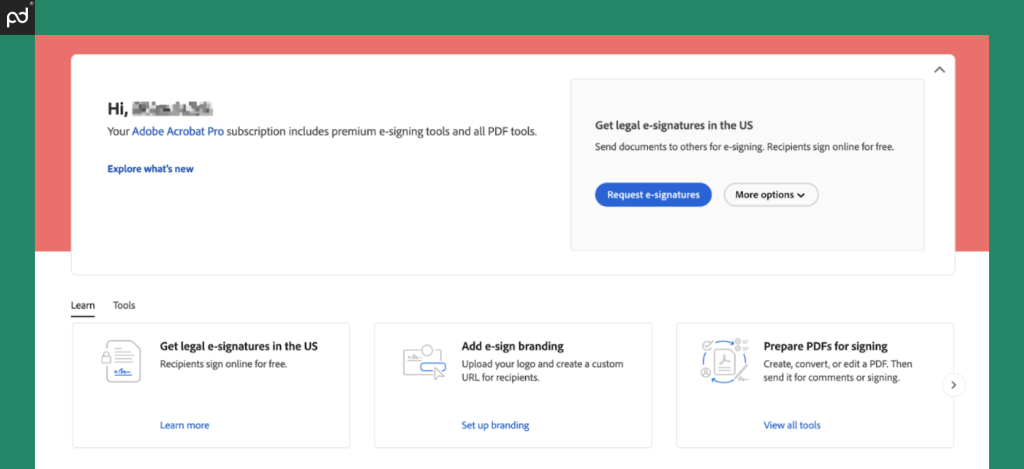
Pricing: Acrobat Standard ($23); Acrobat Pro ($30); Acrobat Standard for teams ($15); Acrobat Pro for teams ($24).
Individual pricing based on monthly commitment. Team pricing requires annual commitment. Enterprise solutions available.
Ease of use: 8.2/10
Free trial: Yes; 30 days.
Support: Knowledge base; support tickets; live chat; additional support plans sold as separate packages.
Adobe Acrobat Sign (formerly known as EchoSign and Acrobat Sign) is part of the Adobe Document Cloud and the Adobe family of apps.
This signing solution works well with most other business-related apps and uses a cloud-based system for signatures and document management.
As part of the Adobe cloud, it’s a natural solution for users working with other PDF solutions, like Adobe Acrobat or Adobe Reader.
Acrobat Sign (full review here) is unique from many other e-signing solutions in that it allows users to natively edit and modify PDF documents.
Where most e-signature tools only allow the use of drag-and-drop fields to prepare a document for signing, Acrobat Sign users can edit documents on the fly before the signing process begins.
This solution is also available at a lower price than DocuSign and other providers, which is great for small businesses looking to streamline their signature process without a huge monetary investment.
DocuSign

Pricing: Personal ($15); Standard ($45); Business Pro ($60).
Enterprise pricing available. All pricing based on month-to-month commitment.
Ease of use: 9.0/10
Free trial: Yes; 30 days.
Support: Knowledge base; support tickets; additional support plans sold as separate packages.
At first glance, DocuSign has it all. In many ways, this e-signing solution is the gold standard for the digital signature process.
DocuSign offers everything from workflow and template creation all the way to geolocation capture and real-time status reporting.
It even integrates seamlessly with most storage solutions (Google Drive, Dropbox, etc.) and with leading CRMs and other major partners at the enterprise level.
You’ll also find DocuSign pricing available to fit your needs, whether you’re a small business, a dedicated team, or you’re seeking a scalable enterprise solution.
From custom support solutions and customization options, DocuSign has you covered.
Acrobat Sign vs DocuSign at a glance
With the basics out of the way, here’s a closer look at the pro-level plans offered by both companies.
| Plan Details | DocuSign | Acrobat Sign |
|---|---|---|
| Plan Name | Business Pro | Acrobat Pro for Teams |
| Core product | ||
| E-signature capture | ✓ | ✓ |
| Real-time audit trail | ✓ | ✓ |
| Notifications | ✓ | ✓ |
| Language support | ✓ | ✓ |
| Mobile app | ✓ | ✓ |
| Reporting tools | ✓ | ✓ |
| E-signing features | ||
| Signing order | ✓ | ✓ |
| Send to multiple recipients | ✓ | ✓ |
| Bulk send | ✓ | ✓ |
| In-person signing | ✓ | X |
| Collaboration tools | ✓ | ✓ |
| Signer attachments | ✓ | ✓ |
| Payment gateway | ✓ | ✓ |
| Document prep | ||
| Drag & drop fields (PDF) | ✓ | ✓ |
| Create reusable templates | ✓ | ✓ |
| From-scratch document builder | X | X |
| Pre-built template library | X | X |
| Form creation | ✓ | ✓ |
| Custom branding | ✓ | ✓ |
| Integrations & API | ||
| Import & storage | ✓ | ✓ |
| CRM | X | ✓ |
| Productivity | ✓ | ✓ |
| API | $ | X |
| Support | ||
| Email / ticketing support | ✓ | ✓ |
| Chat support | X | X |
| Knowledge base | ✓ | ✓ |
| Phone | X | ✓ |
| Premium support options | $ | $ |
This chart compares the two highest-level, non-enterprise plans available for both Acrobat Sign and DocuSign.
While both plans give a broad selection of features, it’s worth pointing out that Acrobat Sign’s pricing structure is far more complicated than DocuSign.
In all, DocuSign offers three basic plan tiers, with each tier unlocking additional signing and collaboration features.
Acrobat Sign offers single-user / individual plans and team plans, all of which are roughly the same price.
Depending on how you organize your signing needs, you might be able to get by with an individual plan.
However, while considering your options, keep in mind that both DocuSign and Acrobat Sign limit the number of e-signature transactions that you can transact with the platform each year.
- DocuSign limits users to 100 envelopes per user/year.
- Acrobat Sign caps usage at 150 transactions per user/year.
Requirements, workflows & pricing
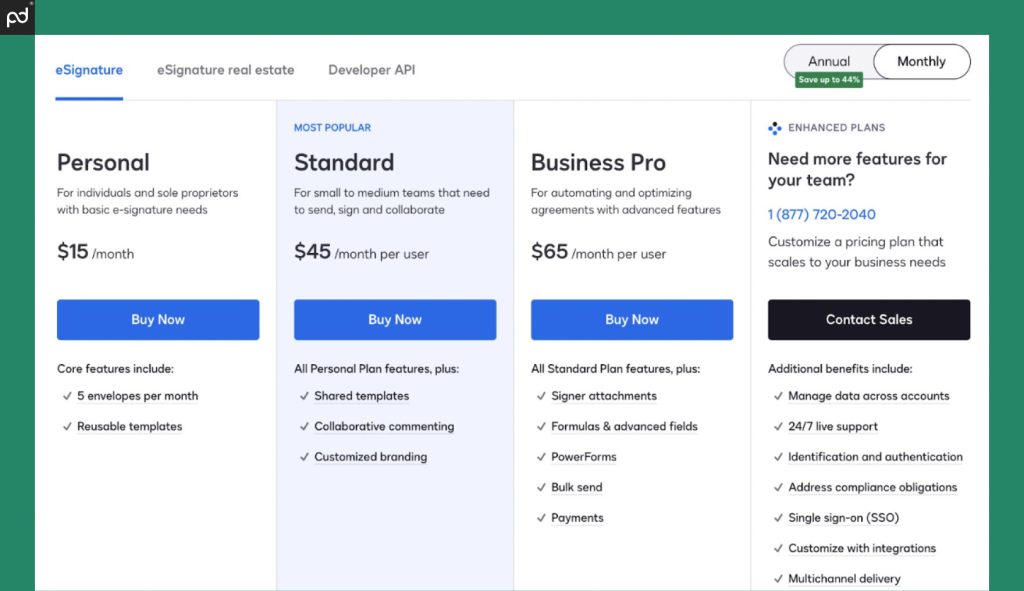
When it comes to e-signature solutions, both DocuSign and Acrobat Sign offer a variety of workflows at varying cost.
In the DocuSign workflow, you’ll work primarily with documents that are nearly complete and ready to be signed.
The drag-and-drop tools that DocuSign offers are primarily to facilitate document signing.
Because of that, DocuSign’s approach comes with certain limitations, particularly in the realm of collaboration and workflow management.
DocuSign only provides limited tools for teamwork and document workflow optimization, which might be insufficient for teams that rely heavily on collaborative efforts or need extensive document handling capabilities.
While additional functionality becomes more available at higher tiers, DocuSign never offers anything other than basic editing and collaboration tools for document modification.
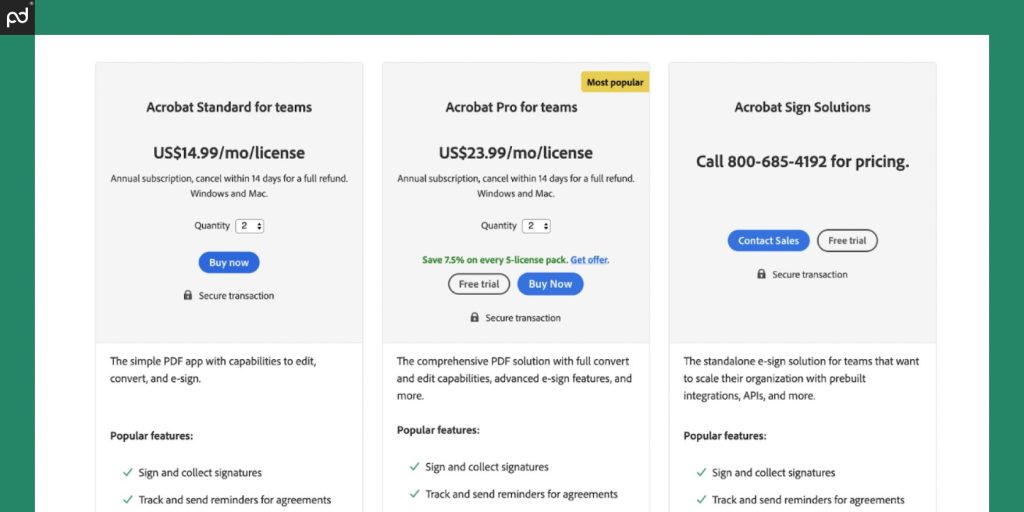
On the other hand, Acrobat Sign offers a full suite of PDF editing tools as part of its product offering in addition to signing features (covered in depth below).
These features allow users to edit and modify PDFs prior to engaging with the signing process, further expanding the use case of the signing platform.
While this approach isn’t as robust as the PandaDoc document editor, which you can use to build documents entirely from scratch, it’s unique in that native PDF editing is rare across signing platforms.
Acrobat Sign is also more cost effective than DocuSign, offering a wider selection of features at lower price points.
In many cases where features overlap, Acrobat Sign offers the desired feature at an earlier tier or for a more affordable price.
For example, payment gateways are available with both DocuSign and Acrobat Sign, but this feature is available through Adobe for as little as $20/month (Pro plan, annual commitment), where DocuSIgn users will pay double that at a minimum.
While the plans still fall short in a few areas — particularly around integrations on the more advanced plans, the standalone platform is an excellent fit for most modern businesses.
Our suggestion
From the perspective of the signing experience, the workflows offered by Acrobat Sign and DocuSign are very similar.
DocuSign is considered by many to be the industry leader in e-signing, but Adobe offers a strong solution at competitive price that comes with a more robust workflow.
Final verdict:
- Acrobat Sign offers a more expansive workflow while providing e-signing solutions at a lower cost when compared to DocuSign.
- DocuSign’s integrations are superior, especially at the enterprise level, where it offers as many as 400+ integrations and custom software solutions in addition to compatibility with most CRMs.
- PandaDoc is a better solution if you’re looking for an end-to-end document workflow, including document editing, e-signing, and management/storage all in one place.
Document editing & preparation
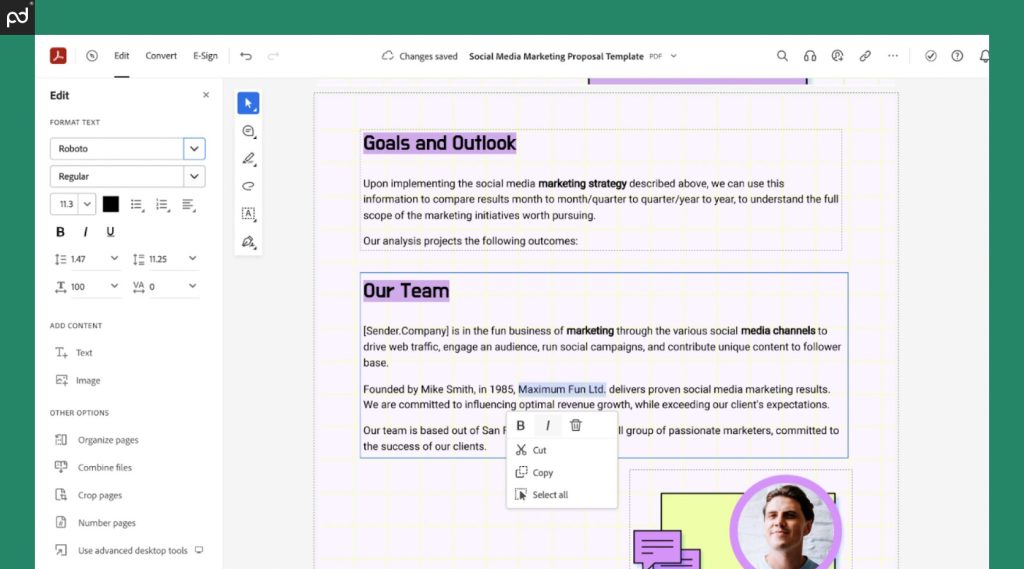
PDF editing is where Adobe Acrobat shines in comparison to DocuSign.
These features are actually derived from Adobe Acrobat, which is incorporated into the Acrobat Sign subscription.
Using Acrobat Sign, you’ll be able to convert documents into PDFs and then extensively modify and customize those PDF documents as part of your document preparation process.
This includes editing text and images, deleting and recording pages, and even redacting sensitive information from documents entirely.
It’s quite an extensive list.
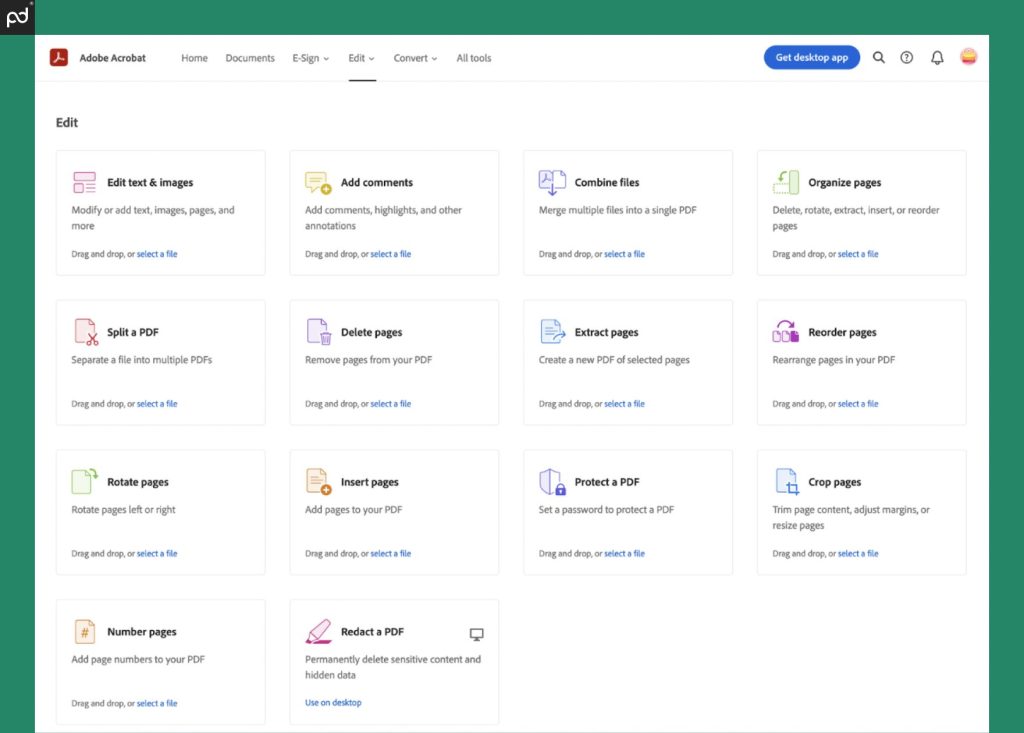
That’s a huge step up from traditional e-signature software solutions.
Traditionally, users follow the signing workflow by uploading a document and preparing it by using drag-and-drop fields like text boxes, date selectors, radio buttons, and signature fields.
When the document is prepared for signing, users can send it via the platform and signers can access the document to sign electronically.
For DocuSign users, this is the standard process.
Acrobat Sign users will have the ability to do all that and more, thanks to the features incorporated through Acrobat Reader.
While not as extensive as what PandaDoc offers, these tools extend the scope of actions users can perform within the platform, making it an effective tool for e-signature capture and document management.
The native PDF editing functionality enables users to interact with PDFs as if they were live documents.
Unfortunately, DocuSign simply doesn’t compete in this area.
With DocuSign, users are stuck with the traditional tools and e-signing process.
It’s simple and effective, but expect to handle all of your editing and document modifications in your word process or a similar document generation tool.
Our suggestion
Whether or not you can use the document editing features provided by Acrobat Sign will depend on your own workflow.
Tools like this can add major flexibility to your e-signing process because they allow for fast modifications during redlining and revisions.
It’s easier to modify documents within existing, collaborative workspaces rather than pulling them back to an offline word processor and re-uploading newer versions.
PandaDoc offers similar editing tools, and our users enjoy the increased convenience in their signing process.
DocuSign doesn’t have a great answer unless you’re willing to consider a separate tool, like DocuSign CLM, which offers document generation capabilities as a companion to e-signing.
- DocuSign provides a no-frills signing process that gets the job done but offloads document editing and major modifications to other platforms and software tools.
- Acrobat Sign users can modify and e-sign PDFs, streamlining their contract negotiation and signing workflow by editing documents without ever leaving the platform.
E-signature & security
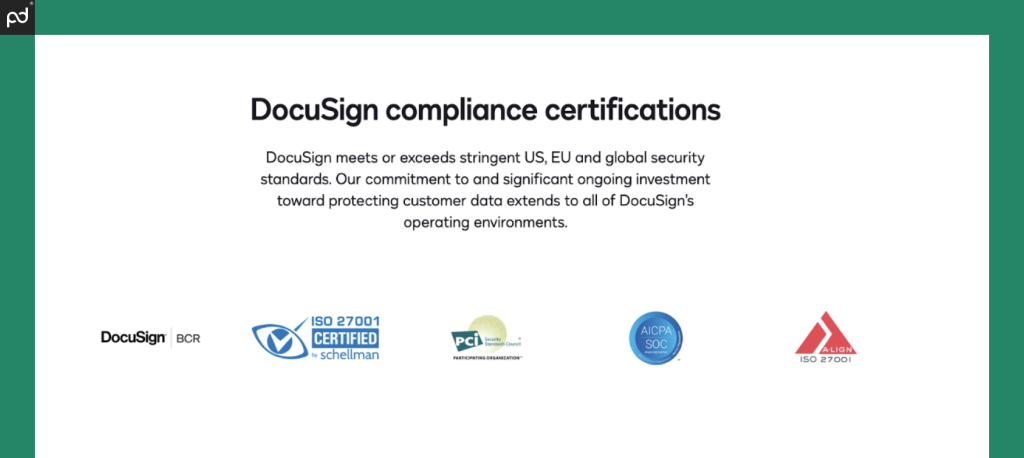
Security is at the core of the electronic signature process.
The ability to know that a signature is valid and that it was signed by the intended recipient is a vital aspect of contracting because it ensures nonrepudiation — that is, the inability to refute responsibility.
Almost every e-signing platform takes this seriously.
At PandaDoc, we’re SOC 2 Type II certified and compliant with HIPAA and eIDAS regulations, among other industry standards.
DocuSign is very similar.
The company complies with multiple industry-recognized standards and is even a key security partner in some prestigious compliance organizations.
By comparison, Adobe falls short here.
While they say they are compliant with many industry standards, it seems like some of the more robust security features are limited to certain e-signing plans.
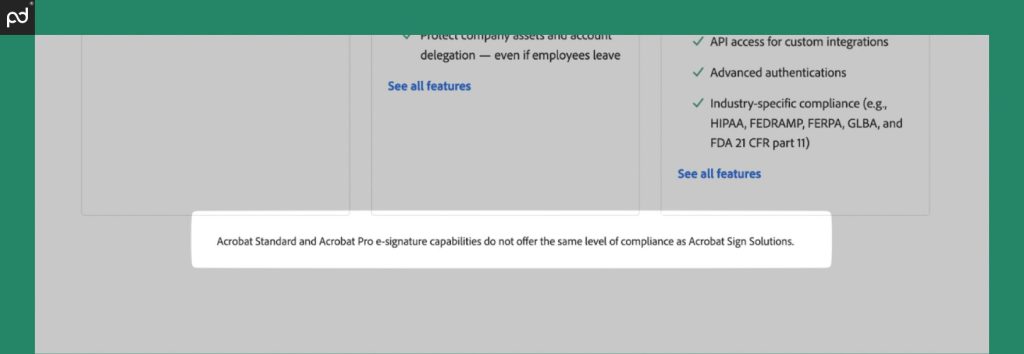
For security-conscious organizations, especially those who want to ensure that business dealings are ironclad, this shortfall may be a dealbreaker.
Some security and compliance measures are still in place for lower-tier plans, but Adobe isn’t clear precisely which features apply and if those features change between the personal- and teams-based plans.
Some certifications may still apply, while others may be reserved exclusively for enterprise partners.
In Adobe’s defense, that’s not entirely uncommon.
At PandaDoc, we restrict HIPAA compliance options to Business and Enterprise plans because of the documentation required to allow us to serve as an effective partner.
Regardless, this is a potential risk that you won’t have to worry about when working with DocuSign, which seems to provide the same level of protection and compliance to all plans.
All that aside, both plans provide authentication by email and phone/SMS, which can provide critical authentication without damaging the customer experience.
Our suggestion
While Adobe offers a huge amount of flexibility, there’s no way to achieve maximum security and compliance with Acrobat Sign unless you’re willing to purchase an enterprise-level plan.
If that’s a major concern for you, DocuSign, PandaDoc, and many other signing solutions offer blanket compliance options with specialized restrictions (usually HIPAA) at higher tiers.
- Acrobat Sign offers decent security for most electronic signatures but reserves higher-end compliance for its enterprise solution.
- DocuSign provides comprehensive document and e-signature security for all tiers, including its individual/personal plans, making this a better fit for security-conscious users.
Integrations
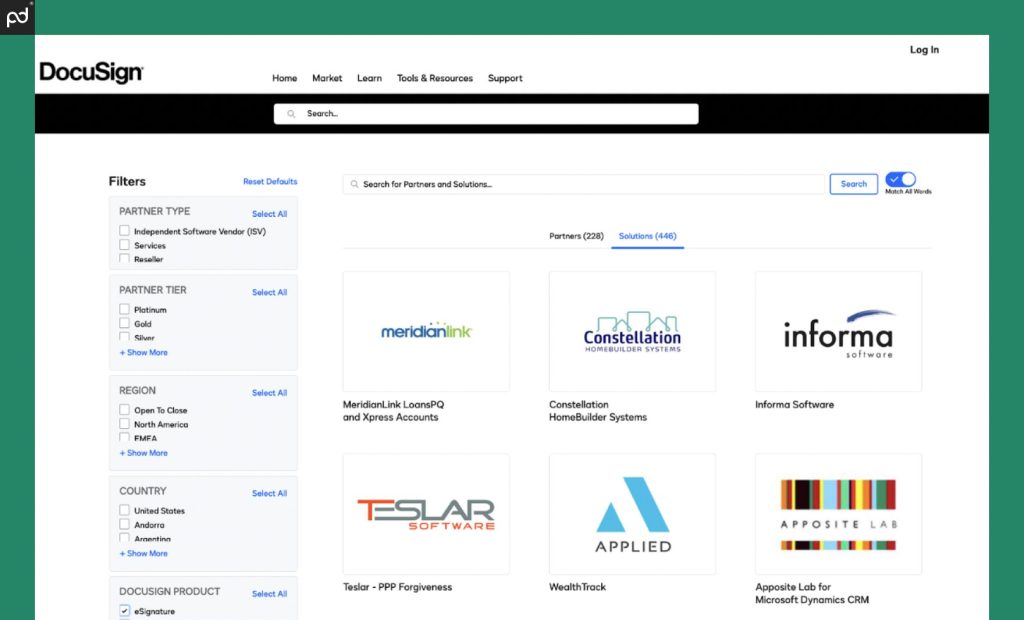
Integrations are hugely important when choosing an eSignature solution, and both Acrobat Sign and DocuSign vary greatly here.
Here’s how DocuSign handles integrations:
- Storage integrations are available on all plans, so users can import documents for e-signing from anywhere.
- Productivity integrations are restricted to Standard plans and above.
- Partner integrations are available on all plans, but they’re narrow in scope and are built to work with very specific software.
- CRM and ERP integrations require a custom enterprise plan from the DocuSign sales team.
This approach effectively limits your ability to work with CRMs and other widely popular, industry-standard software unless you’re willing to sign documents using an enterprise plan.
It’s a different approach than what we use at PandaDoc, where most productivity and storage integrations are available for all plans.
We also offer several CRM integrations available for Business plan users (no enterprise account required), and access to Salesforce for a small, additional monthly charge.
Unfortunately, Adobe’s integration offering is even more limited and somewhat confusing:
- Acrobat Pro (personal plan) users can integrate with Microsoft 365 and Box.
- Users on the team plans can’t use any integrations, including the integrations offered to users on the personal Pro plan (above).
- Enterprise-level users gain access to integrations from Microsoft 365, Salesforce, Workday, and a few others
These options greatly narrow your options if you’re looking to integrate your signing platform with your CRM.
When compared to DocuSign, Adobe just doesn’t offer the capability for simple and seamless integration.
Both DocuSign and Acrobat Sign offer the ability to automate the signing process using API tools, but these require additional resources dedicated to development and usually carry their own pricing plan.
Our suggestion
- DocuSign is the best option if integrations are essential to your business process and you’re looking for a specific partner integration. However, keep in mind that you may pay a substantial amount to access them.
- Acrobat Sign is effective if you’re working with Microsoft 365, Salesforce, and other popular systems. However, the integration options are more narrow.
- PandaDoc is a great fit if you want to consolidate your document creation platform and integrate it seamlessly into your CRM. Most integrations can be accessed even without an Enterprise plan.
Customer support
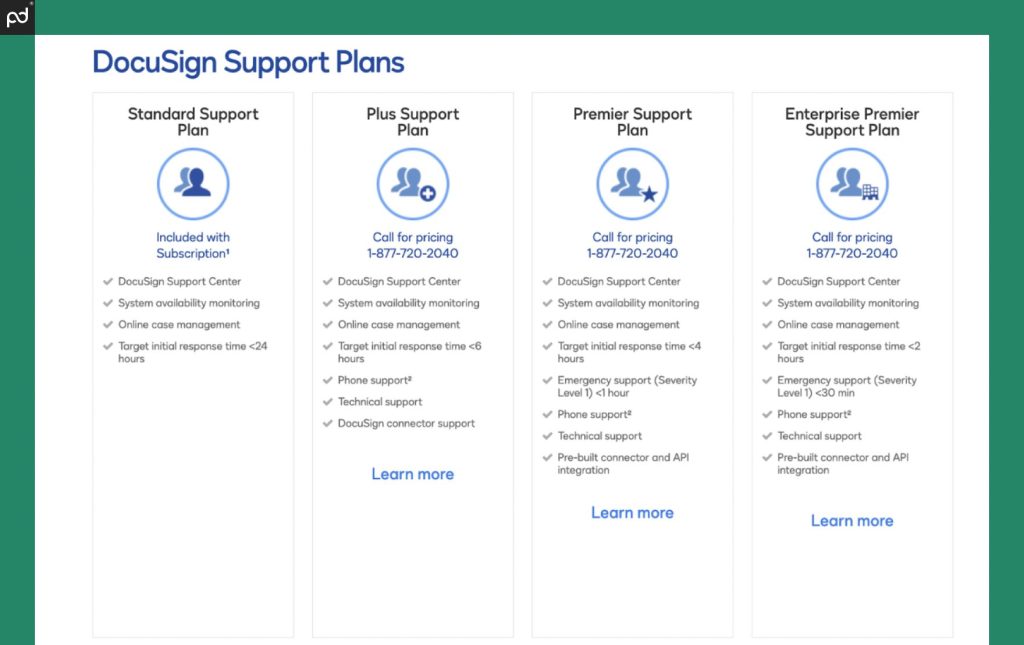
Both DocuSign and Acrobat Sign offer a variety of support options for users, but the level of support varies depending on your plan.
As part of its standard plan, DocuSign relies on ticket-based support options with a 24-hour response time.
Essentially, users will open a ticket and wait for a resolution.
However, more immediate access to support (chat, phone, etc.) aren’t available.
For teams who are willing to invest in premium support plans, DocuSign offers a variety of paid solutions that enhance access and lower response times when support is needed.
Depending on the plan, it’s possible to get phone support, help with integrations, and response times as low as 30 minutes in emergency situations.
It’s also worth noting that DocuSign says that these support options are available around the clock (you can submit a support ticket at any time!), but you’ll still need to wait for your request to move through the system and find an agent.
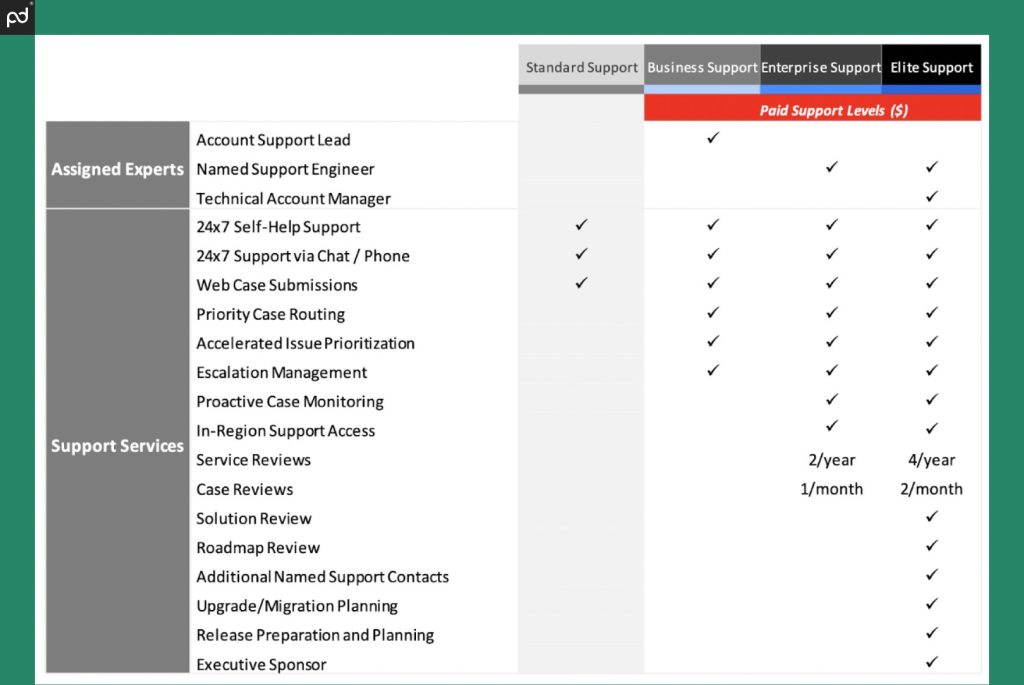
By contrast, Acrobat Sign offers more immediate support solutions, including 24/7 (chat support) as part of their standard support plan.
This is a major advantage over DocuSign, since it’s possible to get help immediately when something goes wrong.
Similar to DocuSign, Adobe also offers premium support levels, which include priority case routing, escalation management, named support engineers, and more.
However, keep in mind that there may be a delay in receiving a final resolution with Adobe.
Standard support outreach is broken into four priority tiers, and responses can vary from between 30 minutes to 24 hours, depending on the level of severity.
If priority support is essential for you, consider your options carefully before committing to one plan over another.
Our suggestion
At PandaDoc, support is something we consider often.
We’re proud to offer 24/7/365 human-powered support for all standard users and premium plans for teams who need a little extra help.
Because of our own efforts to provide outstanding support, we like when other brands take steps to improve the support experience.
- Acrobat Sign offers more immediate access to support, which will create a better experience for most users.
- DocuSign standard support is lackluster compared to Acrobat Sign and other providers, but its premier tiers are a great fit for large/enterprise teams.
- PandaDoc offers a comprehensive support experience that outshines both competitors. (Seriously. Check out the user reviews.)
Alternatives to Acrobat Sign & DocuSign
It goes without saying that both DocuSign and Acrobat Sign are major players in the e-signing market.
But they aren’t the only e-signing services out there.
While these services are essential to modern contract lifecycle management, other players in the industry can bring their own, unique signing solution to your workflow.
Here’s a quick list of other DocuSign alternatives:
Which one should you choose?
While that’s entirely up to you, we’d recommend giving PandaDoc a try.
End-to-end document creation, branding options, and powerful integrations can help you create a seamless document workflow regardless of team size.
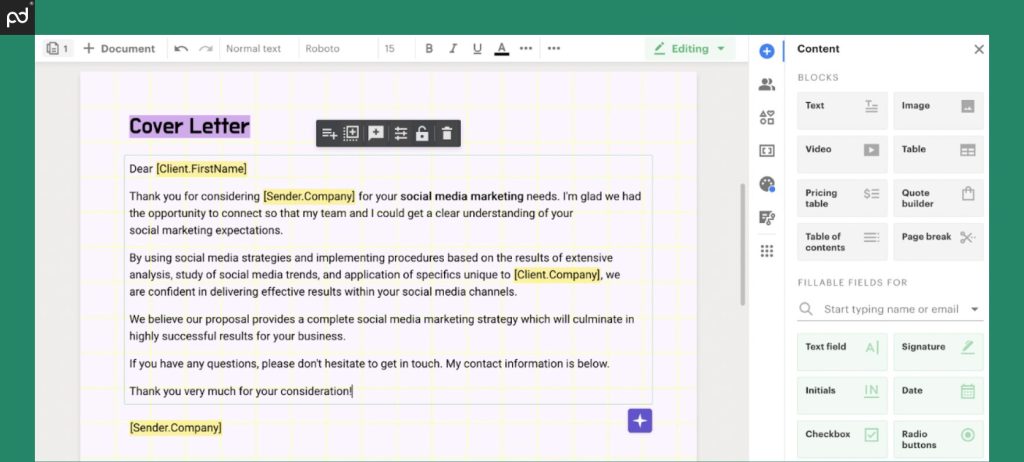
Go beyond electronic signatures
We should be clear that Acrobat Sign and DocuSign are two fantastic solutions for capturing legally-binding electronic signatures.
However, there are plenty of DocuSign and Acrobat Sign competitors out there, so do your own research — and don’t forget to take a look at PandaDoc.
Rather than relying on integrations with Microsoft, Google, or Dropbox for document generation and storage, PandaDoc is an all-in-one solution that provides the tools you need to do everything in one place.
We also have native apps for iOS (iPad and iPhone) and Android devices, plus desktop access through your web browser.
Sign up for a 14-day trial or schedule a demo and see firsthand how PandaDoc can help you build better documents in no time flat.
Originally published March 16, 2020, updated May 2, 2024
Disclaimer
PandaDoc is not a law firm, or a substitute for an attorney or law firm. This page is not intended to and does not provide legal advice. Should you have legal questions on the validity of e-signatures or digital signatures and the enforceability thereof, please consult with an attorney or law firm. Use of PandaDocs’ services are governed by our Terms of Use and Privacy Policy.


